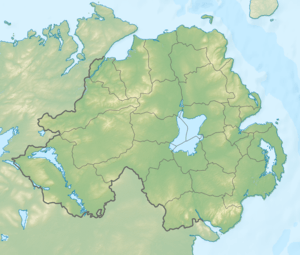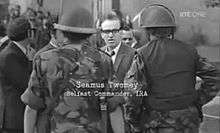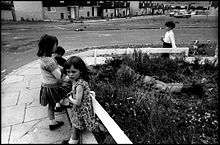Battle of Lenadoon
| Lenadoon Avenue Battle | |||||||
|---|---|---|---|---|---|---|---|
| Part of The Troubles | |||||||
| |||||||
| Belligerents | |||||||
|
| |||||||
| Commanders and leaders | |||||||
|
Brendan Hughes Seamus Twomey | Lance Corporal Paul Johnson | ||||||
| Strength | |||||||
| Up to 100 Volunteers over the six day day period | Several hundered | ||||||
| Casualties and losses | |||||||
| 2 Killed, about a dozen injured | 8 killed, up to 30 injured | ||||||
| 1 Official IRA Volunteer Killed, 1 UDA Volunteer killed, 14 Civilians killed, high number of Civilians injured | |||||||
 Were the battle started | |||||||
The Battle of Lenadoon was a series of gun battles fought between the Provisional IRA and the British Army which started on Thursday, 9 July 1972 in Lenadoon Avenue and then spread to other places in Belfast over the space of six days. Loyalist paramilitaries as well as the Official Irish Republican Army were also involved in some of the incidents. 1972 was the deadliest year of the conflict in Ireland known as The Troubles with almost 500 people being killed that year alone which was as bad as any of the years when sectarian violence broke out in Ulster during the Anglo-Irish War in the 1920s. The fighting broke out after the two week truce between the British Army and the IRA ended.
Background
In 1972 the Troubles had been raging in Ireland for three years since 1969 with the Battle of the Bogside and the August 1969 riotsstarting the conflict. The IRA were fighting to bring about a United Ireland and the British wanted the status quo to remain but with meaningful reforms for the Nationalist minority who had been discriminated against by successive Unionist governments. Almost immediately after Internment without trial was introduced in August 1971 two years after the conflict started violence soared to new heights not seen in Ireland since the 1920s (with the ending of the Irish Civil War in 1923) with shootings, bombings and riots becoming a daily theme of life in Northern Ireland. Between August 1971 - up until February 1975 when the IRA called a long term ceasefire fierce gun battles between Republican paramilitaries the British Army & Loyalist paramilitarieswhere almost a daily occurrence in Belfast especially in West & North Belfast. After Bloody Sunday when the British Army killed fourteen unarmed civilians in what Nationalists & Republicans seen as cold blooded murder by the state the IRA gained large support in the areas they operated in and recruits flooded in to join the IRA and bombings and gun battles between the IRA and British Army and between Republicans and Loyalists became a regular occurrence in Belfast, Derry and other parts of Northern Ireland like large parts of South Armagh, South Down, West Fermanagh and East Tyrone. In June 1972 the IRA's Army Council called a ceasefire to accommodate talks between an IRA delegation and representatives of the British government. The truce lasted barely two weeks with hardline IRA leaders eager to get back to action believing they had the upper hand against the British.
Battles
These are the following series of gun battles that took place which started in Lenadoon Avenue on the 9 July 1972
9 July
Two days after secret talks between the British & IRA broke down the IRA was trying to help Catholics who had been made homeless from the conflict elsewhere in Belfast move into houses in the mainly Protestant Lenadoon Avenue estate which were empty. This attracted a crowd of UDA members and supporters who attacked the houses and before long the British Army arrived on the scene. A stand-off followed for several days until the IRA decided to accompany another removal lorry with another Catholic family into the street but at the last moment the army, fearing a riot, rammed the vehicle with an armoured car. The republican supporters erupted in an angry display, resulting in the soldiers firing rubber bullets, CS gas and water cannons. The Provisionals accused the army and Secretary of State for Northern Ireland William Whitelaw of going back on earlier negotiations and favouring the loyalists. By the evening of the event the IRA announced an end to its ceasefire as a direct response to events at Lenadoon and IRA Army Council member Seamus Twomey who was negotiating with senior British Officers in the area gave a signal to Brendan Hughes who was in command of an IRA unit to open fire on the British Army and a gun battle broke out. Riots and other violence occurred in other areas in Belfast that night. In what became known as the Springhill massacre British Army snipers shot dead five Catholic civilians and injured two others, including a 13-year-old girl, two teenage boys and a Catholic priest. Elsewhere in Belfast three Protestants were found shot dead in a semi burnt out car in Little Distillery Street just of the Grosvenor Road, its believed Republican paramilitaries were responsible fore these killings although no specific group claimed responsibility for the killings. Another Protestant civilian was found shot dead near the waterworks of Cavehill Road also killed by Republicans. Also in Belfast a 60 year old Catholic civilian was shot dead by the British Army while driving his car near the Falls Road. And the IRA shot dead a UDA member in the Markets Area of Belfast. In total eleven people were killed on the 9 July in Belfast.

10 July
More gun battles and rioting took place the following day although nobody else was killed. William Whitelaw admitted secret talks had taken place between the IRA and British government. [1] [2] [3]
11 July
The IRA attempted to blow up a British Army observation post in Lenadoon Avenue, using a mechanical digger loaded with a massive bomb in its bucket. A Volunteer drove the machine into the billet and his comrades surrounded the billet and fired thousands of shots to cover him but the bomb failed to explode properly.[4][5]
12 July
Two more people were killed in Belfast A Catholic civilian was killed by Loyalists in Southport Street and a Protestant civilian was killed by Republicans near Springfield Road.

13 July
Several gun battles took place in Belfast between Republicans, Loyalists and the British Army resulting in the deaths of seven people. Three British soldiers were killed by IRA Volunteers in separate incidents around Belfast. A UDR soldier was shot dead by a Loyalist gunman. The British Army shot dead an IRA Volunteer and a Catholic civilian during a gun battle in Ardoyne. And a Catholic civilian was also shot dead by the British Army while leaving Glenparl Social Club in Glenpark Street. [6]
14 July
Six hundred extra British troops were sent into Lenadoon Avenue to confront the IRA as the IRA had taken over most of the estate at this stage in the battle, this resulted in fierce gun battles which resulted in the deaths of a further six people. A Provisional IRA Volunteer was shot dead by the British Army as he walked through Unity Flats in Upper Library Street. A PIRA sniper shot dead a British soldier in Lenadoon Avenue. Another PIRA sniper shot dead a British soldier this time in Ardoyne. A Protestant civilian was shot dead by the Provisional IRA outside her home during an IRA sniper attack on the British Army Highpark Drive. The British Army shot dead an Official IRA Volunteer during a gun battle in Ardoyne. And a the last death of the battles was a British soldier who was shot dead by a PIRA sniper during a gun battle in Ardoyne. [7] William Whitelaw speaking in the House of Commons said that the IRA had used a rocket launcher in one of the battles and that they had six of them in their inventory to date. The IRA also exploded a car bomb in Alliance Avenue damaging a number of houses. [4] [8] [9]

Aftermath
The IRA continued to intensify their campaign of bombing, sniping and ambushes. Just one week after the end of the battles around Belfast the IRA carried out one it's largest bombing operations ever, in what became known as Bloody Friday when the Provisional IRA planted and exploded 22 car bombs in Belfast City in the space of 75 minutes, killing 9 people and seriously injuring approximately 130 others. Ten days after Bloody Friday the British Army launched its largest operation since the Suez Canal crisis called Operation Motorman to retake the "No Go" areas from the IRA & Loyalist paramilitaries. The Operation was a success. On the same day as Operation Motorman the IRA exploded three carbombs in Claudy killing nine people, the warnings given by the IRA were in inadequate. [10]
See also
References
- ↑ http://cain.ulst.ac.uk/proni/1972/proni_CAB-9-G-27-6-3_1972-07-10.pdf
- ↑ http://cain.ulst.ac.uk/othelem/chron/ch72.htm#Jul
- ↑ https://belfastchildis.wordpress.com/2016/07/09/10th-july-deaths-events-in-northern-ireland-troubles/
- 1 2 "U.K.: FIVE DEAD AFTER BELFAST'S BIGGEST GUN BATTLE OF THE YEAR.". Archived from the original on 19 July 2011.
- ↑ "AN PHOBLACHT/REPUBLICAN NEWS".
- ↑ https://belfastchildis.wordpress.com/2016/07/12/13th-july-deaths-events-in-northern-ireland-troubles/
- ↑ http://cain.ulst.ac.uk/cgi-bin/dyndeaths.pl?querytype=date&day=14&month=07&year=1972
- ↑ http://archives.chicagotribune.com/1972/07/15/page/1/article/10-killed-in-ulster-i-r-a-fires-rockets
- ↑ https://belfastchildis.wordpress.com/2016/07/13/14th-july-deaths-events-in-northern-ireland-troubles/
- ↑ http://cain.ulst.ac.uk/othelem/chron/ch72.htm#Jun